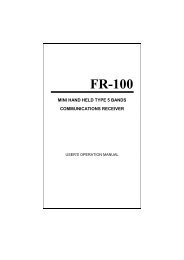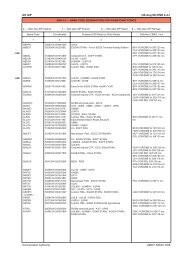PSR-295 Portable Scanner OWNER’S MANUAL
PSR-295 Portable Scanner OWNER'S MANUAL - Radios-UK
PSR-295 Portable Scanner OWNER'S MANUAL - Radios-UK
You also want an ePaper? Increase the reach of your titles
YUMPU automatically turns print PDFs into web optimized ePapers that Google loves.
amateur radio transmissions. When the scanner receives<br />
a transmission on a channel set to the FM mode, it always<br />
stops on the transmission.<br />
CTCSS Mode (CT)<br />
CTCSS mode sets the scanner to receive transmissions<br />
using frequency modulation (FM) with Continuous Tone<br />
Coded Squelch System (CTCSS) subaudible tone codes.<br />
CTCSS allows multiple users to share a single radio frequency<br />
without hearing each other’s transmissions. In<br />
your <strong>PSR</strong>-<strong>295</strong> scanner, the CTCSS feature can be used<br />
to block the reception of transmissions on shared channel<br />
to only those that use the CTCSS tone that you have<br />
specified. CTCSS mode also features a Code Search<br />
setting that allows you to display and store unknown<br />
codes into the channel memory. CTCSS tones can sometimes<br />
be heard as a low “hum” in the background of a<br />
voice transmission. Many systems that use CTCSS transmit<br />
a special “turn off code” at the end of each transmission.<br />
The turn off code causes a properly equipped receiver<br />
to mute before the transmission ends, eliminating<br />
the “squelch tail” burst of noise the commonly occurs<br />
when the signal is lost. CTCSS turn off code performance<br />
can be affected by weak signals.<br />
DCS Mode (DC)<br />
DCS mode sets the scanner to receive transmissions<br />
using frequency modulation (FM) with Digital Coded<br />
Squelch (DCS) subaudible data signaling. DCS is very<br />
similar to CTCSS, except that a digital code is transmitted<br />
instead of an audio tone. Like CTCSS, DCS allows<br />
multiple users to share a single radio frequency without<br />
hearing each other’s transmissions. In your <strong>PSR</strong>-<strong>295</strong> scanner,<br />
the DCS feature can be used to block the reception<br />
of transmissions on a shared channel to only those that<br />
use the DCS tone that you have specified. DCS mode<br />
also features a Code Search setting that allows you to<br />
display and store unknown codes into the channel<br />
memory. DCS data can sometimes be heard as a low<br />
“purring” sound in the background of a voice transmission.<br />
Some DCS systems transmit a special “turn off code”<br />
at the end of each transmission. The turn off code causes<br />
a properly equipped receiver to mute before the transmission<br />
ends, eliminating the “squelch tail” burst of noise<br />
the commonly occurs when the signal is lost.<br />
13<br />
Page 13<br />
2004/07/06, 15:37






